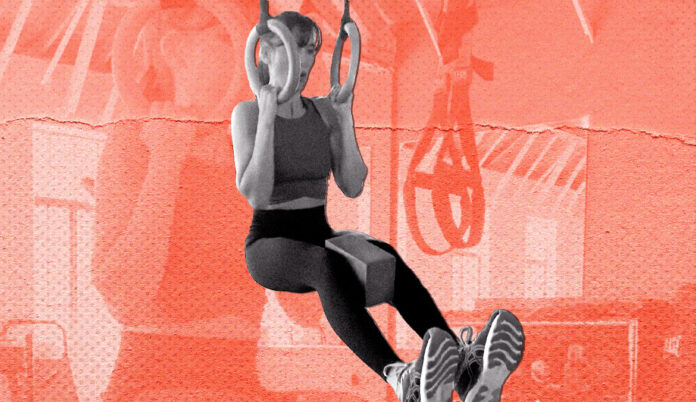In an Instagram clip posted by Brie, the actor (most identified for her work on the TV collection Glow and Neighborhood) will be seen holding onto gymnastic rings and pulling her total physique up a number of inches off the bottom whereas sustaining an L-sit posture. In a single video, Brie performs the transfer whereas squeezing a yoga block between her knees; in one other, she’s balancing a hefty drugs ball on her thighs.
“I see you @jessicabiel,” Brie wrote in her Instagram caption, with the hashstag “#inspo.” Final month, actor Jessica Biel shared an Instagram video of herself doing the identical super-human transfer along with her husband, Justin Timberlake.
The transfer, which Biel’s coach Ben Bruno calls an “L-sit ring chin-up,” requires some critical power, each within the higher physique and the core. “That is a complicated train that requires important power, steadiness, and adaptability,” says Jay Cardiello, CSCS, licensed power and conditioning specialist whose shopper roster contains Jennifer Lopez and Rami Malek.
In fact, it is no marvel Brie can full this transfer. She’s been coaching at Rise Motion, residence of movie star coach Jason Walsh, for years, and he or she additionally not too long ago signed on for Masters of the Universe, a live-action He-Man film, the place she’ll play a super-strong villain.
When Bruno first shared a video of Timberlake knocking out 10 reps of this superior transfer, he commented, “It is a very, very spectacular show of core and higher physique power. Go attempt it for your self to see simply how tough that is.”
The mechanics of the transfer
The L-sit chin-up, very like a daily chin-up, works a variety of upper-body muscular tissues, together with the lats, biceps, shoulders, and stabilizing muscular tissues in your again. However “the instability of the rings challenges your higher physique greater than conventional chin-ups or pull-ups,” says Cardiello.
Plus, with the ability to pull your total physique weight off of the ground whereas sustaining that L-sit posture additionally requires tons of engagement out of your core and hip flexors, that are working to carry your legs straight through the transfer. And also you wager your pelvic flooring is concerned: For those who battle to interact your pelvic flooring throughout a transfer like this, “think about incorporating pelvic flooring–particular workout routines, like Kegels or diaphragmatic respiration, to construct consciousness and power in that space,” says Cardiello.
Meaning with the intention to do that one with good type, it’s essential have already got some full-body power constructed up. This is the appropriate method to do that expert-level chin-up variation, in accordance with Cardiello.
How one can do an L-sit ring chin-up
“On this model, you maintain a block between your knees, which will increase core engagement and promotes higher physique alignment,” says Cardiello. “The instability of the rings provides a further problem, requiring extra give attention to steadiness and coordination.”
- Sit on the bottom underneath a set of safely secured gymnastics rings. Maintain one ring in every hand, palms going through towards you or towards one another.
- Lengthen your legs straight out in entrance of you, flexing your toes. Have interaction your core and and raise your legs so your thighs are parallel to the ground whereas sustaining a agency grip on the block.
- Whereas sustaining the L-sit place with the block held between your knees, pull your self up towards the rings by bending your elbows and squeezing your shoulder blades collectively. Intention to deliver your chest near the rings, preserving the block between your knees all through the motion.
- Slowly decrease your self again to the beginning place in a managed method, guaranteeing that your core stays engaged and the block stays secured between your knees.
Not there but? Do not be discouraged: Constructing power like this takes a very long time. Begin with a modified model, says Cardiello. “Attempt preserving your knees bent at 90 levels to type a tucked L-shape along with your torso and thighs,” he says. Working as much as a chin-up or pull-up on a hard and fast bar can also be a terrific place to start.
Issues to look out for
For those who do have the power to tug off an L-sit chin-up (and, wow, I am impressed), these are the issues to bear in mind.
Core engagement
You could give attention to core engagement to get this transfer to work. “In case your core will not be sturdy sufficient, you might have hassle preserving the block safe between your knees,” says Cardiello. “This will result in arching your decrease again or shedding the L-sit place.” He recommends specializing in preserving your pelvis tucked underneath and your abs braced.
Leg motion
You probably have hassle sustaining the block between your knees with out leg motion, the effectiveness of the train is not going to be nice. Modify the transfer as it’s essential guarantee your thighs stay parallel to the bottom.
Shoulder security
“Like with all pull-up variations, it is necessary to retract your shoulder blades earlier than pulling up,” says Cardiello. It will forestall pointless pressure in your shoulder joints.
Ring instability
Rings naturally transfer greater than a hard and fast bar, so it’s essential give attention to controlling your actions. “For those who’re not used to rings, begin slowly to keep away from swaying or utilizing momentum,” says Cardiello. Beginning on a hard and fast bar is an effective variation for this transfer, too.
Fatigue
You are going to really feel this transfer, and quick. Watch your fatigue ranges to make sure you aren’t getting injured. “An L-sit ring [chin-up is] demanding on each the core and higher physique, particularly with the added instability,” says Cardiello. “Begin with fewer reps and give attention to type earlier than rising quantity.”


